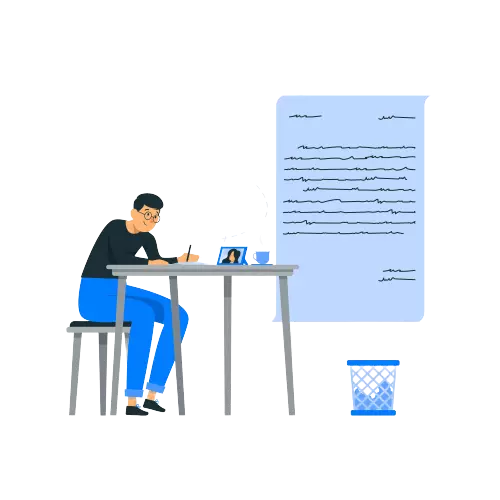Using ChatGPT to Write an Essay
Published by at August 30th, 2023 , Revised On January 15, 2025
Navigating the world of essays can sometimes feel like steering a ship through a storm. With demands for clear structure, solid arguments, and impeccable grammar, essay writing is a skill that requires time and practice to master.
But what if you had an AI-powered tool to help? Enter ChatGPT – a cutting-edge language model designed to aid and assist in many writing tasks. Let’s explore how you can leverage ChatGPT to craft the perfect essay. Before that, it is important to know what ChatGPT is.
What is ChatGPT?
ChatGPT is a version of the OpenAI GPT (Generative Pre-trained Transformer) model designed specifically for conversational tasks. GPT is a type of machine learning model for natural language processing and understanding.
ChatGPT, being based on this architecture, is adept at engaging in human-like conversations. Depending on the version, such as GPT-3.5 in your case, the model can have tens or even hundreds of billions of parameters. After being trained on vast amounts of data, these parameters allow the model to generate human-like responses in conversations, answer questions, write essays, create stories, and much more.
However, it is important to note that while ChatGPT can generate human-like text, it doesn’t possess consciousness, emotions, or intent. It generates responses based on patterns it learned during training and does not have understanding or beliefs in the same way humans do.
The Advantages of Using ChatGPT for Essay Writing
Using ChatGPT for essay writing offers several advantages, with technology playing an increasingly important role in the modern educational environment. Here is an in-depth look at the benefits you have listed:
Speed and Efficiency in Generating Essays
- Instantaneous Responses: Unlike humans, who might need time to think and process information, ChatGPT can instantly generate responses.
- Consistency: Regardless of your many queries, the system remains unfazed and can operate without breaks, ensuring consistent performance.
- Customisation: Users can ask for essays to be simplified, expanded upon, or presented in various styles based on their preferences.
A Wide Range of Knowledge and References up to the Last Training Cut-Off
- Vast Information: Built upon a substantial dataset, ChatGPT is acquainted with many topics from literature, science, history, and more.
- No Need for External Research: For many general topics, users won’t have to sift through multiple sources for information. ChatGPT can provide a consolidated overview.
- Accuracy: The model has been trained on diverse and reputable sources, ensuring high reliability in its essay. However, users should always double-check facts and figures, especially for critical writing.
Ability to Brainstorm Ideas and Provide Multiple Perspectives
- Diverse Thought Process: Given its extensive training, ChatGPT can present various viewpoints on a subject, mimicking a brainstorming session with multiple experts.
- Idea Generation: If a user is unsure about which angle to approach a topic, ChatGPT can suggest a range of options.
- Feedback Loop: Users can iterate with the model, refining ideas until they reach a satisfactory conclusion.
Reducing Writer’s Block
- Prompting Ideas: When faced with the dreaded writer’s block, a conversation with ChatGPT can guide you in the right direction.
- Breaking Down Complex Topics: Users can gain clarity and overcome writing hurdles by asking the model to explain concepts in simpler terms or provide an outline.
- Maintaining Flow: Whenever users get stuck, they can quickly obtain suggestions, ensuring the writing process remains smooth and uninterrupted.
How to Use ChatGPT to Write an Essay
Using ChatGPT to write an essay can be a transformative experience, streamlining the research and writing process. Here’s a step-by-step guide on how to use ChatGPT effectively for essay writing:
Determine the Essay Topic and Objective
Before you start, be clear about what you want to write. If you are unsure, you can ask ChatGPT for topic suggestions or current trends related to a broader theme.
Initial Research
- Use ChatGPT to gain a general understanding of your topic. Ask for summaries, major points, key figures, dates, or other relevant information.
- Request sources or references to validate the information. Although ChatGPT’s last training cut-off was in 2021, it can guide you to seminal works or crucial references up to that date.
Brainstorm and Outline
- Ask ChatGPT to help brainstorm different angles or perspectives on your topic. This will give you a more comprehensive view and can lead to a more in-depth analysis.
- Create an essay outline. You can ask ChatGPT for a suggested structure based on your topic and the points you want to cover.
Drafting the Essay
- Start with the introduction. If you are unsure how to begin, ChatGPT can provide opening sentence suggestions or help you frame your thesis statement.
- For the body, use the information gathered during your research. You can ask ChatGPT to expand on certain points, provide examples, or even help with transitions between paragraphs.
- For the conclusion, ChatGPT can help summarise your main points and suggest how to close the essay effectively.
Review and Refinement
- Read it through once you have a draft to ensure coherence and flow. If certain sections feel lacking, you can ask ChatGPT for additional essays or ways to enhance the section.
- Ensure that the essay retains a personal touch. While ChatGPT can provide information and structure, the unique voice, insights, and perspectives should come from you.
Citation and Referencing
If you have used specific facts, figures, or ideas, ensure they are properly cited. While ChatGPT can guide you to key works up to its last training cut-off, it’s crucial to visit the sources for accurate citations.
Proofreading
Ask ChatGPT about grammar rules, sentence structures, or word choices to refine your essay. However, using dedicated proofreading tools or having another human review your work is also a good idea.
Feedback
Sometimes, it is beneficial to gain feedback before the final submission. You can present your essay or specific sections to ChatGPT and ask for feedback or suggestions for improvement.
The academic papers we write have:
- Precision and Clarity
- Zero Plagiarism
- High-level Encryption
- Authentic Sources

Refinement and Proofreading
In an age where Artificial Intelligence (AI) like ChatGPT can generate essays at a rapid pace, the value of human intervention in the refinement and proofreading stages of writing remains undeniable. This is especially true for tasks that demand a nuanced understanding, personal touch, or individual stylistic flair.
Why Human Touch is Still Essential
- Understanding: A human reader can pick up on subtleties, innuendos, cultural contexts, and emotional undertones in ways that AI, despite its sophistication, might miss.
- Ethical Considerations: Humans can discern the ethical implications or sensitivities of a particular statement or idea, ensuring the essay does not unintentionally offend or misrepresent.
- Authenticity: Readers often seek genuine and authentic voices. The human touch ensures the authenticity of experiences, feelings, and reflections that AI cannot genuinely replicate.
Checking the Essay for Relevance and Coherence
- Contextual Relevance: While AI can produce factually correct information, humans can gauge the appropriateness of that information within a specific context or audience.
- Logical Flow: Humans can better understand and appreciate the natural flow of an argument or narrative, ensuring the essay doesn’t merely present facts but tells a cohesive story or argument.
- Eliminating Redundancies: Humans can detect and remove repetitive points or ideas that don’t add value, ensuring conciseness and relevance.
Making Sure AI-Generated Essay Aligns with Personal Voice and Style
- Individual Style: Every writer has a unique voice and style, from their choice of vocabulary to the rhythm of their prose. Humans can ensure that an AI-generated essay meshes seamlessly with their style.
- Consistency: If an essay or article has both AI-generated and human-written sections, humans can ensure consistency in tone, style, and voice throughout.
- Personal Touch: Personal anecdotes, experiences, or reflections cannot be AI-generated. Humans can integrate these personal elements, ensuring the essay remains relatable and genuine.
Frequently Asked Questions
Table of Contents
Yes, ChatGPT can be used to assist with essay writing by generating ideas, clarifying concepts, and structuring content. However, ensuring originality, verifying accuracy, and maintaining a personal voice in the final output is essential to avoiding over-reliance on AI.
Yes, ChatGPT can help reword your essay, enhancing clarity, improving structure, and ensuring variety in expression. However, always review its suggestions for accuracy and coherence, ensuring that the revised content aligns with your original intent and adheres to academic standards.
To use ChatGPT for essay writing, input your topic or question, and use the generated content as a guide. Extract ideas, refine arguments, or seek clarity on concepts. Always review, edit, and personalise the output, ensuring originality, accuracy, and alignment with your essay’s objectives and personal voice.
To avoid plagiarism with ChatGPT, use it for brainstorming, understanding concepts, and structure guidance. Never copy verbatim. Cross-check facts, rephrase AI-generated content and infuse your original thoughts. Ensure citations for external sources and check your essay with plagiarism detection tools before submission. Always prioritise originality and personal insight.






